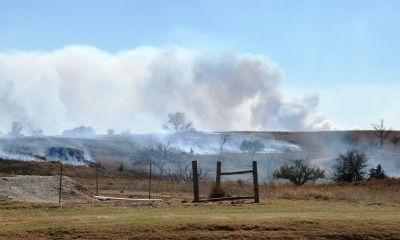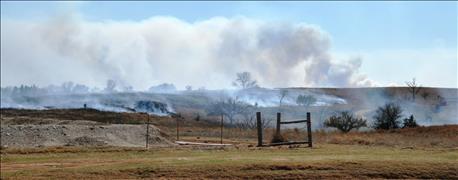
Hundreds of square miles of the Kansas Gypsum Hills were charred and black beneath two inches of snow on Easter morning.
Mama cows and their baby calves lie dead in pastures, killed by burns or by choking smoke. Others, moved to safety ahead of the killer flames, are recovering from respiratory issues and burns while munching on welcome hay delivered over the past three days from ranchers from near and far.
At least one elderly couple is homeless; their house, outbuildings and all their possessions gone up in smoke. Dozens of other ranchers have lost stored hay, equipment, outbuildings, fences and other supplies.

sSTILL BURNING:The Anderson Creek wildfire in Barber and Comanche counties contiunues to burn in spite of a welcome weekend snowfall that slowed the progress of the blaze and allowed firefighters to gain on containment,
The wildfire that began west of Alva, Okla., in the overnight hours Tuesday was still burning in Barber County and hot spots were continuing to flare in Comanche County on Sunday in spite of overnight snow that covered the area with welcome moisture.
On Saturday, winds finally died down enough that National Guard helicopters could move in to put out hot spots in the canyons and washes. Welcome rain and snow overnight brought the fire into 81% containment by Sunday night,
"We had a few sprinkles of rain on Friday night and Saturday," said Chris Boyd, who farms near Isabel and is coordinating the donations of hay to storage piles and direct to the ranches where it is desperately needed. "It wasn't enough to help anything, but the helicopters coming in really helped get it contained. The wind finally died down enough and they got the front line under control enough that they could do that."
Gov. Sam Brownback has issued a disaster declaration, clearing the way for the apparatus of government to move into place to help those who have lost livestock, outbuildings, machinery, hay and grain.
Even as the region's weary firefighters struggle against wind-whipped flames, scores of firefighters and first responders from all over Kansas are moving into the region, providing back-up and additional equipment. Many are volunteer firefighters, taking time without pay from their regular jobs to risk their lives to help their neighbors.
Regional ranchers who have been spared were the first to load flat-beds of big round bales and head to the fire-stricken region. By Thursday afternoon, trailers from across the state were rolling into Farmers Equity Cooperative locations in Medicine Lodge and Coldwater, bringing load after load of bales for distribution across the region.
By Saturday, Boyd said the immediate need had been met and had started taking names and phone numbers to contract ranchers if more hay is needed over the next several weeks.
"We have enough for the immediate future," Boyd said. "But depending on how long it takes for the grass to come back, we could need more over the next several weeks. We're asking people to slow down the flow and spread it out over the next several weeks. We have a long road ahead."
The Kansas Livestock Association, which had initially called for hay donations, switched its request to cash donations to help ranchers rebuild the thousands of miles of fence destroyed in the blaze.
On Friday afternoon, rancher Ted Alexander was buying gate posts from a gas station vendor in Medicine Lodge to replace burned posts on his ranch 19 miles west of Medicine Lodge.
Alexander, who said his ranch was "100%" burned in the wildfire added that he won't be using hedge posts when he replaces fence.
"I had posts that were brand new and they burned down to just ashes. The fire was that hot," he said. "I'm doing pipe mounted in concrete. No more of those big hedge corner posts. They are smoldering and sparking and re-igniting the fire," he said.
He said the barbed wire of his fences was damaged by the heat of the fire and is now brittle and easily broken.
"It looks OK, but if you whack it with a piece of wood, it breaks," he said. "The heat left it brittle."
Alexander said he has done prescribed burns and weathered wildfires on his ranch for more than 30 years and he has never seen anything close to as devastating as this fire.
"We were warned," he said. "Forecasters have been telling us that we are set up for devastating wildfires. This has been building since 2010. We had all the drought years with everything dried out. Then we got a couple of years with a lot of rain in the fall and early winter that had the grass really growing. But the spring was dry and windy and we couldn't burn it off. The cedars grew. And the fuel load was just tremendous. That is what set us up for this."
Alexander said he hasn't completed an inventory of his cattle, but he opened gates and let them find their own route to safety ahead of the flames. He said he had 34 bulls on the ranch and all are accounted for and okay.
"The mama cows with little babies are another story," he said. "They couldn't move as fast and the fire caught some of them."
The loss of infrastructure is mind-boggling.
Bridge and railroad trestles have been burned. Poles supporting power lines have been charred by the thousands.
"It will take years to build back everything that burned in just hours," Alexander said.
About the Author(s)
You May Also Like






